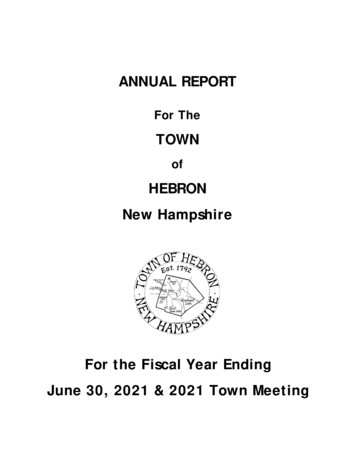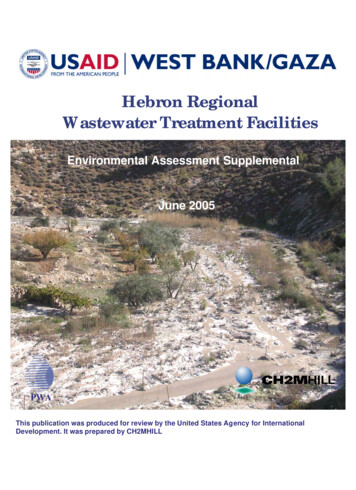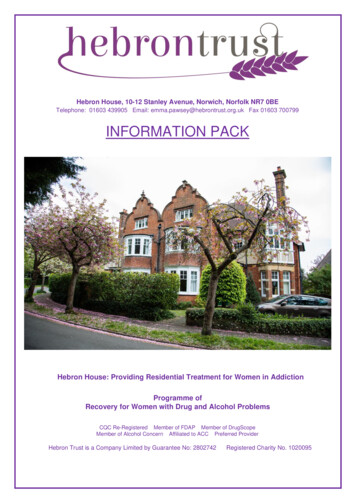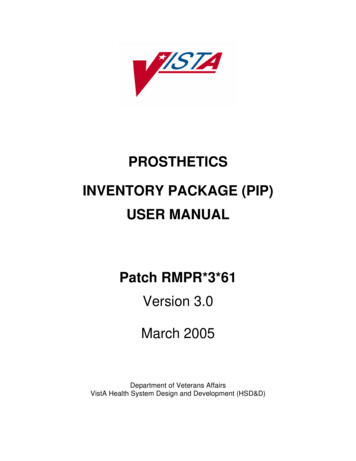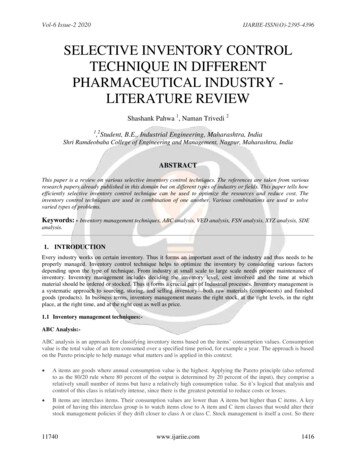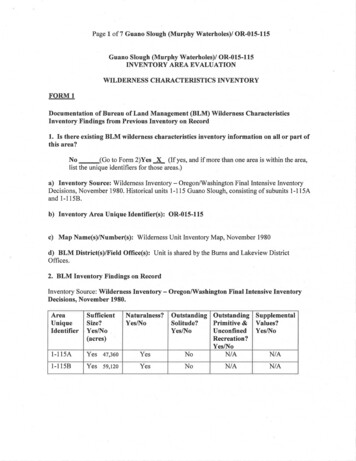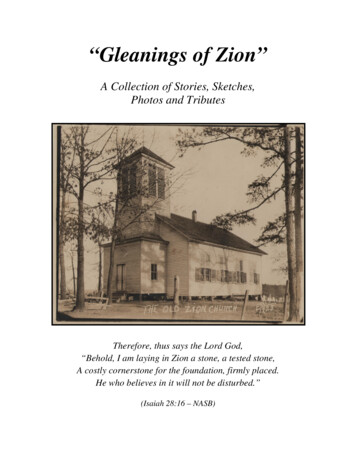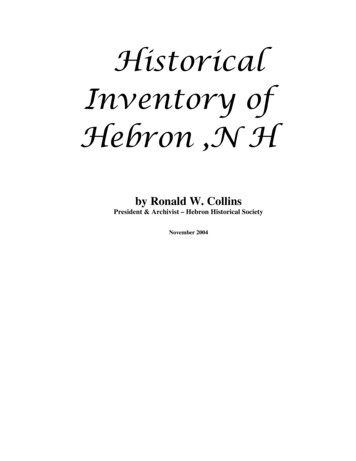
Transcription
HistoricalInventory ofHebron ,N Hby Ronald W. CollinsPresident & Archivist – Hebron Historical SocietyNovember 2004
IntroductionThe Historical Inventory of Hebron consists of houses, barns, a bridge, a road and homesites of historical significance.Extant Historical House InventoryHouse BuilderRueben HobartUriah PikeGeorge WorthenAbijah WrightSamuel HazeltonDaniel PikeJohn HazeltonJonathan K. PikeJonathan MorseSamuel CrosbyEnos FerrinDaniel WalkerDate c1813c1820c1835Extant Historical Barns InventoryBarn BuilderJonathan MorseGeorge SmithDate Builtc18031907Historical Bridge InventoryBraley Road Bridge built c1927Historical Road InventoryCollege Road built c 1772Historical Home Site InventoryFamilyNathaniel BallStephen OrdwayNathaniel S. BerryHistorical SignificanceCousin to George Washington; father of John Ball founderof Grand Rapids, MI and Portland, OR; father of DeborahBall Powers, first self made millionairess in the US.Brother to Sergeant John Ordway, who was 3rd in commandof the Lewis & Clark Expedition.Governor of New Hampshire during the Civil War andadvisor to President Abraham Lincoln-2-
Historical CampsCamp PasquaneyCamp OnawayCamp Mowlis18931900 as CampRedcroft1903Oldest continuously operatedboys camp in the UnitedStatesOldest operating girls campin the United StatesMap of Historical House Locations-3-
ContentsIntroduction .2Map of Historical House LocationsContents.3Contents.4Inventory of Extant Historical Houses.5Rueben Hobart House c1782 .5Uriah Pike House c1782 .6George Worthen House c1784.9Jonathan Morse House c1784.15Abijah Wright House c1785 .17Samuel Hazelton House c1790.18Daniel Pike House c1791.20John Hazelton House c1798 .21Jonathan K. Pike House c1803 .23Enos Ferrin House (Meadow Wind) c1820 .25Daniel Walker House c1835.28The Parsonage c1840.29Samuel Crosby House c1813.31Samuel Noyes House c1840 .32Inventory of Historical Barns .34Jonathan Morse Barn c 1806 .34George Smith Barn c1907 .35Historical Bridge Inventory .36Historical Road Inventory.37Historical Home Site Inventory .40Nathaniel Ball Home Site .40Stephen Ordway Homesite .42Nathaniel S. Berry home site .44Historical Camps .46Camp Pasquaney.46Camp Onaway .46Camp Mowglis .47-4-
Inventory of Extant Historical HousesRueben Hobart House c1782Rueben Hobart House (presently ownedby David and Mavis Brittelli) is sometimesreferred to as the “Gibbs House” or “JewellAcres.” This house built by Rueben Hobartone of the original settlers of Hebron inc1782. This is probably the oldest house inHebron. Rueben Hobart was born probablyin Groton, MA on January 26, 1761, the sonof Gershom Hobart, and died May 6, 1810 inHebron. He married (1) Isabel Colburn1788. She was born Abt. 1757 in Hollis,NH, and died September 23, 1795. Hemarried (2) Elizabeth ? Aft. 1795. She wasborn Abt. 1778. Rueben Hobart was one ofthe first settlers in Cockermouth, now Hebron, NH. Rueben’s brother, Josiah (1765-1812), wasthe first male child born in Plymouth. All of Rueben’s children were probably born in this house.Children of Rueben Hobart and Isabel Colburn are:i. Abpha Hobart, b. June 28, 1789.ii. Rueben Hobart, b. June 14, 1791.Children of Rueben Hobart and Elizabeth ? are:iii. Isabel Hobart, b. June 15, 1798, Hebron, NH; d. April 4, 1812.iv. Elizabeth Hobart, b. June 14, 1802, Hebron, NH; d. April 1, 1826.v. Hannah Hobart, b. October 28, 1804, Hebron, NH; d. September 23, 1809.vi. Lucy Hobart, b. April 27, 1807, Hebron, NH.vii. Joshua Hobart, b. July 7, 1809, Hebron, NH.-5-
Uriah Pike House c1782Uriah Pike House (presently owned byDr. Howard and Caroline Oedel) wasbuilt c1782 and is one of the three oldesthouses in Hebron. Uriah Drury Pike wasborn July 7, 1761 in Dunstable, NH, anddied October 18, 1822 in Hebron, NH.He married Hannah Keyes, daughter ofJonathan Keyes and Elizabeth Fletcher.She was born May 6, 1761 in Westford,MA, and died February 11, 1833.Probably all of Uriah’s children wereborn in this house.i. Ezekiel Pike, b. August 5,1783; d. April 27, 1784.ii. Ezekiel Pike, b. May 1, 1784; d. February 12, 1805.iii. Uriah Pike, b. November 13, 1785; d. June 10, 1790.iv. Isaiah Pike, b. August 12, 1787; d. September 16, 1865; m. Charlotte Hickok.v. Hannah Pike, b. June 21, 1789; d. June 26, 1861.vi. Rhoda Pike, b. January 23, 1792; m. Thaddeus Hickok.vii. Captain Uriah Pike, b. July 29, 1794; d. June 24, 1878, Hebron, NH.viii. Jonathan Keyes Pike, b. May 10, 1796; d. September 29, 1859.ix. Jacob Kendall Pike, b. May 23, 1798; d. May 23, 1804.x. Isaac Pike, b. October 5, 1802; d. September 24, 1832.xi. Nathaniel Ball Pike, b. March 26, 1805; d. May 30, 1828.After Uriah Drury’s death his son Captain Uriah Pike inherited the farm. He married NancyPage, daughter of Thomas Page and Betty ?. She was born September 20, 1796, and diedFebruary 25, 1870.Children of URIAH PIKE and NANCY PAGE born in this house are:i.ii.iii.iv.v.vi.AUSTIN FRANKLIN9 PIKE, b. October 16, 1819, Hebron, NH; d. October 8, 1886, Hebron, NH. Whowas a member of the House of Representatives 1873-1875 and a US Senator in 1883.AMANDA M. PIKE, b. March 12, 1821; d. January 1, 1878; m. JOHN F. WHITTEMORE.EMELINE D. PIKE, b. January 1, 1823.URIAH A. PIKE, b. December 5, 1826; d. November 17, 1832.NATHANIEL ADAMS PIKE, b. June 22, 1832.HARRIET A. PIKE, b. January 20, 1838; d. August 10, 1885; m. ROMULUS A. BUCKLAND,August 10, 1870.The following information is taken from the hand written notes of William N. Oedel.The first deed transfer for this property occurred in 1782. For the price of 75 thefollowing transfers were made to Uriah Drury Pike: from Thomas Nevins about 63 ½ acres; plus½ of Lot #1 in the 3rd Range, 2nd Division, minus 5 ½ acres; plus Lot #2 in the 3rd Range less 5½ acres less 44 rods. In 1790 another 50 acres was purchased for 40 from Moses Little which-6-
was in Lot #11, 2nd Division, 1st Range. In 1802 for 25, 50 acres were added from a purchasefrom Nahan Ward from Lot #12, 2nd Division, 1st Range. In 1807 3 acres were purchased for 12from Stephen Goodhue which was part of Lot #10, 1st Range. Another 20 acres was added in1809 for 50 from Abel Colburn which was the east end of Lot #10, 1st Range. In 1815 JobCilley sold Uriah Drury another 10 acres for 100 which was part of Lot #9, 1st Range. Again in1816 Job Cilley sold another 17 square rods from the south side of Lot #10. In 1818 Jonathan K.Pike sold 10 acres to Uriah Drury for 50 which was a piece of the west side of Lot #6, 2ndRange. Finally, sometime later the 50 acre Glebe Lot was added to the property but the exactdate is not known. This brought the total holdings of Uriah Drury Pike to 206 ½ acres and 17 sq.rods for a total cost of 864.50.Uriah Drury Pike held title to all this land until April 22, 1818 when he deeded all of theproperty to his son Uriah Pike accept for 5 ½ acres of the Nevins lot which had been sold toDaniel Pike. The deed to Uriah also included 1 ½ pews and 1 horse shed at the Meeting House.Uriah did not record this deed until 1854 when he sold the property.AUSTIN FRANKLIN PIKE (1819-1886) was the son of Uriah and Nancy (Page) Pikeand grandson of Uriah D. Pike. He was born in this house. He prepared for college but changedhis plans when his health broke down, and after reading law with Hon. George Nesmith ofFranklin, N.H. was taken into partnership. He served in the N.H. House of Representatives andin the state Senate, and was President of the Senate and Speaker of the House. He was elected tothe U.S. House of Representatives for the years 1873-1875. In 1883 he was elected a U.S.Senator, but died before his term was completed. He owned homes both in Franklin and Hebron.On the 1860 county map the residence of A. F. Pike, Esq. is about a quarter mile south of theHebron-Groton road where Myron Braley has recently constructed a road. In 1873 Pike boughtthe old Samuel Hazelton homestead on Braley Road from Wilson W. Hazelton. His son, EdwardA. Pike, took over the place in 1879 and farmed there until 1888. Biographical information aboutAustin F. Pike may be found in The Bench and Bar of New Hampshire by C. H. Bell, theBiographical Directory of the American Congress, and other places. There is a portrait in NewHampshire Men, edited by George H. Moses.In 1854 Uriah Pike sold 60 acres to Sally Colby and the remainder, including the housewas sold to Ichabod P. Hardy for 1500. Ichabod Hardy received about 140 acres as well as thehorse shed at the Meeting House. His abutters were the families: Veasey, Sanborn, Wise,George, and Whipple. He only held it for one year.In 1855 Ichabod Hardy sold the property, minus a 4 acre meadow, to Moses Pike for 1500. He held on to the property until 1859 when the abutters were: Fretts, Dustin, Crosby andFerrin. Evidently land was changing hands quickly during that time period.In 1859 Moses sold the property for 1400 (land prices were falling, which may explain why somuch was changing hands) to Levi K. Ball who held it for 33 years. Ball was a Mexican WarVeteran. In 1862 he sold to Willard Wise for 300 15 acres east of the road but reserving thecider mill and for his lifetime the income from certain apple trees. This same 300 acres was soldby Willard Wise to a Mr. Dustin for 300 in 1863. Ball mortgaged the farm to Sarah Jones andon his death in 1891, his daughters, as sole surviving heirs, conveyed the property to for 1 in aQuitclaim Deed. Cecil Davis told the following story about Levi Ball’s last sickness. Levi wasquite ill and the neighborhood took turns staying with him at night. Cecil Davis was quite youngand this particular night Ball suffered a good deal. In the middle of the night Ball called to Davisto get his pocket book in the bureau. Then he asked Davis to get his gun from behind the door.This having been done, Ball produced 2 from the pocketbook and handed it to Davis saying-7-
“This is all I have just now but you take it and then shoot me.” This was quite to a disturbingsituation for young Davis who apparently felt quite scared, and so it made a great impression onhim. He didn’t shoot Levi but he was very happy to see the dawn and when he did he high tailedit out of the Ball house.John Jones held the deed for approximately 1 tear and sold the property in 1892 toGeorge W. Lufkin for 500.In the deeds to Lufkin the property line is stated to be the road, whereas before the farmincluded property on both sides of the road. However, since Lufkin also owned the old MiloCrosby place, as well as, the old Ferrin property, so he now owned from the road up to the oldJesseman Road on the other side of Tenney Hill, and he was bounded on the south by AmbroseAdams. When Lufkin sold the property the deed included his entire holdings. He sold all thisproperty to George MacDougall in 1906 for 1200.George must have transferred or left to property to his son, Gordon, because the nextdeed lists Gordon as Grantor. When Gordon MacDougall sold the property in 1911 it onlyincluded the land that had been purchased from John Jones back in 1892, so MacDougall kept allof the old Crosby and Ferrin property on top of Tenney Hill. He sold the truncated property toBernard E. Adams in 1911 for 800 (about what Uriah Drury Pike paid back in early 1800’s).Adams held it until 1928 when he sold it to George R. Wolverton who held it for 17years.Wolverton mortgaged the property to the Methodist-Episcopal Trust Fund for 650.In 1945 the property was sold to William N. Oedel for 2500, who also bought fromCecil Davis the site of the old cider mill east of the road, which was about 1600 square feet, for 10 in 1953. Upon William’s death, in 1966, the property was inherited by its present ownerHoward T. Oedel.-8-
George Worthen House c1784George Worthen House (presentlyowned by the Hillside Inn CondominiumAssociation). Referred to today as the HillsideInn. In the 1700’s, following the Revolution,the land around New Found Pond, as it wascalled then, was subdivided into ranges andlots. Lot #10 in the 3rd range was purchasedby George Worthen. The adjoining lot on thesouth was owned by the Fowler family, and onthe north it was bordered by land owned byAsa Hobart. Around 1784 George Worthenbuilt a one story house, an adjoining shed andattached barn.A year after its construction theWorthen farm faced its first natural challenge. The records read “Oct. 1785 – More rain thanusual had fallen in Sept., so with the ground well saturated, the immense rainfall that came raninto the lake, and streams, producing the greatest freshet ever known on the Pemigewasset River.9 inches of rain fell, doing much damage to the low lands and drowning many cattle. The waterwas ‘about 30 ft. above the bed of the river.’”At the time the house was built the main pathway (road is too grandiose a term)connecting Bristol (then called New Chester) to Cockermouth (later Hebron) ran up the west sideof the lake. It was in 1803 that the Mayhew Turnpike was built on the east side, passing in frontof the Worthen farm. The Turnpike was built to shorten the distance between Concord andPlymouth. The Turnpike was sixteen miles long and started south of Bristol at the PeasleyGraveyard on Smith River and ran to the present Route 3A and Route 25 traffic circle inPlymouth. The toll gates were discontinued in 1840, and the road given to the towns to maintain.Stage coaches from Haverhill, N.H. to Concord traveled on regular schedule over the MayhewTurnpike from about 1814 until 1850 (or possibly 1855) when the railroads drove them out ofbusiness. "Soon after 1820 the government established a mail route from Concord throughPlymouth to Haverhill At the same time, another post route was established from Concordthrough Bristol, Bridgewater, West Plymouth (i.e. East Hebron) and Rumney to Haverhill."(History of Plymouth, I:341-343)In the 1840's the stages to Haverhill via East Hebron, Bristol and the Mayhew Turnpikeleft Concord on Tuesdays, Thursdays and Saturdays. The southbound stages on this routeapparently left Haverhill on Mondays, Wednesdays and Fridays. An 1845 advertisement of aproposal to carry mail indicates that these were four horse coaches.It was the Mayhew Turnpike and its associated stage traffic that brought, in the 1870s and1880’s, the tourist that resulted in the Worthen farm becoming the Hillside Inn.The Worthens survived the spotted fever (typhoid) epidemics of 1816, 1817 and 1821that killed many Hebron residents. In these epidemics some families lost 5 and 6 children withina few weeks. As if epidemics were not bad enough, the Worthems and the old farm housesurvived the earthquakes of 1814 and 1817. It was in 1821 that Worthen sold the farm to-9-
Timothy Ferrin. The deed specified that Ferrin bought the buildings and 10 acres on the “Pond”side of the road for 100.There was heavy team traffic on the Mayhew Turnpike at that time, transporting northernNew Hampshire products to the cities and towns further south, and bringing back manufacturedproducts and other goods not produced on northern New Hampshire farms.Traffic on the Mayhew Turnpike declined sharply with the opening of the Franklin andBristol railroad which had been completed in 1848; another branch of this railroad was openedfor traffic from Concord to Plymouth in 1850, and completed to Woodsville in 1853. With theadvent of these railroads, the traffic through East Hebron greatly diminished.During the years Tim Ferrin owned the property that was to become the Hillside Inn(1821 to 1860), life was not always easy in East Hebron. There was a major winter flood inFebruary 1822 when several inches of rain fell on ground covered in ice. Having no way to soakin, the rain ran into every lake and stream lifting and breaking the ice thus creating huge icedams that washed down the rivers leaving practically no bridges in tact north of Concord. Thenin 1835 a small pox epidemic swept the area, followed in 1849 with the return of typhoid. Finallythere was the disastrous winter of 1856-57 when the area suffered 32 major snow storms. ByMarch of that year there was more than 6 feet of snow cover, with drifts reaching twice that, andthe temperature dipped as low as –30 degrees, never coming above zero for the entire month ofJanuary. The old farm and the tough New Hampshire families endured.Evidently Tim Ferrin either owned adjacent property or he purchased some between 1821and 1860, because in 1860 he sold to his son-in-law and daughter, Benjamin and Clara (Ferrin)Smith, the buildings, orchard, meadow, a total of 135 acres for 1500. Ferrin stipulated thefollowing condition as part of the sale to Benjamin Smith:“That Smith, his executor and administration, shall att all times during the naturallifves of the said Tim and Abigail Ferrin provide for and sufficiently support and maintain thesaid Tim and Abigail in the house where they now reside and there provide with suitable meats,drinks, cloths, nursing medicine and all other things necessary, proper and convenient in sicknessand health, and shall at all times during their natural life, treat them kindly and affectionately as achild should their parents.”The words in are indecipherable in the original document and the supplied words are theauthor’s best guess.Benjamin Smith did not have to accommodate his mother and father-in-law for very longas Abigail (Morse) Ferrin died on June 8, 1864, and six days later on June 14, 1864 Timothydied as well. The Ferrins died just after the diphtheria epidemic ran through the village in 1863.At the time of their deaths, Tim was 85 years old and died of lung congestion (i.e. pneumonia)and Abigail was 77 having died of a heart disease.In 1869 the Smiths sold the farm to Uriah Merrill for 3000.A passenger and mail stage from Bristol to Hebron and Groton started operation before1870. The Bristol Enterprise for January 4, 1879 advertised that the charge for carryingpassengers or express between Bristol and Hebron was 15 cents. The Star Mail Route and StageLine, as it was called, ran past the Merrill farm twice daily as the stage made the 3 hour, 12 milerun from Bristol, through Bridgewater, East Hebron, Hebron to Groton and returned.Undoubtedly, the Merrill farm was a favorite stopping and refreshing point.It was in the 1870's, thanks to the stages, that the beginning of the tourist migration to theNewfound area countryside started. Many, mostly fishermen and hunters at first, and leisureseekers later started searching for accommodations during their visits to the lake area. The- 10 -
village of Hebron had all the necessary attributes at the time to attract visitors: fishing, hunting,scenery, nature walks, boating, and sources for good meals. The gradual influx of summertourists necessitated places to stay. Immediately, some local farmers capitalized upon thesituation as a good means to supplement their income. Extra bedrooms in a farmhouse along withall the old fashioned home cooking were an irresistible temptation to many visitors. It added upto a business bonanza for this small rural town struggling for existence with the demise of herformer small industries and trades. Grove Hill Farm with proprietor John W. Sanborn and hiswife was the first to move into the boarding house business in 1875.Uriah Merrill died on April 21, 1881 and the farm was inherited by his son RichardMerrill. It was after the passing of Uriah Merrill that the “Yellow Day” mystery occurred. Therecords read “1881 – Sept. 6 was called ‘Yellow Day’. For several days previous, the smell ofsmoke had filled the air. There were no clouds, but the sun and sky were red in the earlymorning. As noon approached this changed to a yellow, and everything to be seen, buildings,foiliage, and the sky, assumed the same shade. It seemed strange and weird, and an unusualsoberness rested on everyone, as though expecting some coming calamity. Lamps werenecessary in dwellings and stores, cattle came to the barns as for the night, and hens went toroost. 2-3 days passed before the atmosphere was as clear as usual.”It is not known if “Yellow Day” was a result of the earthquake of 1881 or due to a largeforest fire somewhere far to the west of Hebron.Well, the calamity never came and on November 30, 1881 Richard and Sarah Merrill soldthe major piece of the farm at auction to George S. and Emma (McClure) Smith for 2100.George S. Smith probably was not related to Benjamin Smith who had owned Hillsidefrom 1860 to 1869, but Emma McClure Smith was certainly related to the Merrill family fromwhom the Smith’s bought Hillside, as she was the granddaughter of Uriah Merrill, and niece ofRichard Merrill.When the sale to the Smith’s was made, Richard and Sarah Merrill retained title to thesouthern most portion of the farm, and this portion, nearly 55 acres, which stretched along thelake and on both sides of the Mayhew Turnpike, became the Merrill campground and the landpresently along Merrill Road.So what the Smith’s purchased was the farm buildings and remaining 80 acres.Considering that the amount of land sold to the Smiths was little more than half of the original, itis no surprise that the much reduced farm sold in 1881 for 900 less than it did in 1869. As itwas, the Smiths bought it as a fix-it-upper. Evidently the old farm house and building wereshowing their age (nearly a hundred years at that time).The farm as it was purchased by George Smith in 1881 is just as George Worthen built itin 1784, and the barn that was later to become the dining room (now the north section of the Inn)didn’t exist in its present form, the shed was only half the size of the present middle section (andonly a single story). Where the driveway that leads to the lower condo units is now, there is alarge barn and a smaller shed just to its north. Today’s large red barn is not yet in existence.George and Emma Smith’s new purchase had an ideal location as an inn but the farmrequired a good amount of work to fix it up before guests could be taken in. It should be notedthat it appears that Hillside received its name from George and Emma as the name does notappear in any extant documents before they purchased the farm.Working diligently, within a year or so after the purchase, probably in 1882, George andEmma Smith opened their home as a boarding house for fishermen and hunters and started theHillside Inn. Other Hebronites taking in between 10-25 boarders were John Sanborn, Edmund- 11 -
Barnard and Richard Merrill. All provided boating, riding, fishing and bathing. It was also in1882 when another earthquake hit the Hebron area.Due to its popularity, the available room at Hillside soon proved inadequate. In 1884 theroof of the Hillside Inn was raised and a second story was added, giving the south end of the Innits present look. The Smith’s added the second story strictly for the purposes of attracting morepaying guests.Evidently adding the upper story worked. During one week in the summer of 1886 thenumber of people visiting Hebron and staying at the various local establishments were: GroveHill Farm (John Sanborn) 25, Hillside Inn (George Smith) 40, Merrill’s Campground (RichardMerrill) 14, and Edmund Barnard’s (now Mowglis Camp for Boys) 30, for a total of 109 visitors.Not bad considering how hard it was to travel to Hebron in 1886.Improvements continued at Hillside all during the 1890’s and into the 20th century. It isnot clear when the middle “shed” was improved and its roof raised, and the “dining room” barnwas added but this happened after 1890 and before 1912 based on the photographs availablefrom that time.There is no record if any of the changes and improvements at Hillside were due tonecessity but it is recorded that earthquakes hit the Hebron area in 1887, 1890, 1891, 1893, 1897and 1902.After Emma’s death, on June 8, 1896, George married Florence Bowles, and it wasFlorence who decided that she wanted a higher class of guests than hunters, trappers andfishermen. So, Florence contacted Mr. Wilson, head of Camp Pasquaney and convinced him thatthe Inn, after a little fixing up, would be a good place for parents to stay when delivering, visitingor retrieving their children from the camp. Mr. Wilson, after a tour of the Inn, agreed and startedsending parents there.The rooms and venue were superior to other local establishments and the prices chargedat Hillside was competitive.It was about 1907 that the large red barn, that today so distinguishes Hillside Inn, wasbuilt, along with a wash house and other buildings nearer the lake. Richard Braley says thatwhile the Red Barn was under construction it was hit by lighting, and as a result lightning rodswere installed on the barn and Inn.In 1912 a 2 ½ acre piece of the Hillside property, where “White Chimneys” is presentlylocated, was sold to a Mrs. Blume.Just next to the Red Barn is today’s work shed, but originally this was the Inn’s IceHouse where ice cut from the lake was stored all summer to keep drinks cool, and to make icecream. Bud MacDougall used to hand-crank the ice cream maker for the Inn.Behind the barn toward the lake, two buildings stood which are now gone. Nearest to thelake was the Wash House (where all the Inn laundry was done by Nellie Ferrin). It stood whereMal and Sylvia Green’s condo unit #17 is located. In fact, the rock wall that forms part of Maland Sylvia’s garden was part of the foundation of the old wash house. Bud MacDougall andsome of the other hired help slept in a bedroom attached to this wash house.Between the Wash House and the Ice House (now the shed) stood a garage for guest’sautomobiles.In 1925, the “Burrage Cottage” was split off the southern edge of the property and sold toEdith Burrage. She built the existing house (which she called Highstead – the name can still beseen over the entranceway) a
October 8, 1886, Hebron, NH. Who was a member of the House of Representatives 1873-1875 and a US Senator in 1883. ii. AMANDA M. PIKE, b. March 12, 1821; d. . AUSTIN FRANKLIN PIKE (1819-1886) was the son of Uriah and Nancy (Page) Pike . Austin F. Pike may be found in The Bench and Bar of New Hampshire by C. H. Bell, the Biographical .
